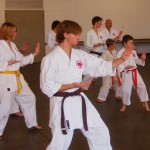It’s a semantic debate, but I feel it requires some elaboration and definition: What is the difference between a fighting style and a martial art, and what constitutes what?
This work is, of course, my opinion of the difference and is meant to inspire debate over the meanings of these apparent synonyms – to help clarify an otherwise muddy and grey area.
A fighting style is, essentially, exactly how it sounds – a practice designed for fights and fighting. Its focus is on the act of fighting and the conflict itself, which then gears its practices and training towards this end. And, after the practitioner has trained for a while, they will test their mettle in the ring or arena and determine effectiveness or areas of improvement for future conflicts in the ring/arena.
It’s focused on the venue to which it subscribes, and adheres to the associated rules/regulations (if any) in its training regiments, etc. And, to put a broad stroke to this, it focuses on what is believed to ‘work’ in practical terms (as defined by their rules, etc.)
A martial art on the other hand, is a practice that focuses on the refinement of the individual as well as giving them competency in combat. A martial art is a practice of combat meant to inspire personal betterment, not simply focus on physical victories.
Arguably it is the addition of supra-individual concepts to the practices themselves that are fundamental to the difference I am putting forward. In a martial art, one will endeavour to make their movements as ‘perfect’ as they feasibly can, and articulate motion for optimal use – and to learn the focus and discipline necessary to control themselves in more ways that simply the physical.
Now I’m not going to categorize any practice into either of the boxes I’ve just defined – that would just be arrogant. The practitioner of any practice is the variable in this definition. Essentially, I’m saying that practitioner of a ‘fighting style’ could be a martial artist, while a practitioner of a ‘martial art’ could be a fighting stylist. It comes from the personal approach they take to their practice, and if it applies beyond the confines of their training.
An example of a fighting style (generically, to illustrate my point only) would be Boxing. The focus of the training is on making one a better fighter so as to defeat their opponents in the ring. It’s not meant for self-defence (but it can be and is used in such a manner, like a wrench isn’t a hammer but can be used to hit things…)
The practice is geared towards competition, with all of the exercises specifically designed to improve the physical aspects of the competitor, and competitors are categorized based on size, weight, and skill (measured in Knockouts, wins, ties, and losses): all attributing/indicating physical skill and competence.
A martial art example would be Aikido (of which I am not a practitioner of specifically, and I use the illustration in an attempt to mitigate the appearance of bias). Aikido uses the physical as a tool and gateway to something higher – it holds an inherent notion of passivity (without being a ‘pushover’) that it exploits and explores within their expression of their art. It holds that a path to world peace begins inside every person, and that violence as an expression will only reflect and inspire more violence. Their training and evaluations are exercises in focusing or defusing situations without injuring the aggressor – and this includes in non-physical encounters as well.
The mastery of oneself is the goal, and competitions typically aren’t what are trained for.
This being said – I would like to illustrate the complexity of the issue that I’m bringing up. Essentially, at the most reduced form of what I am saying, a fighting style focuses on the fight and besting opponents, and a martial art focuses on the training the besting and bettering of oneself.
The attitude of the practitioner plays a key role in the expression of what they do; as I previously mentioned that a boxer could be a martial artist and a Karateka could be a fighter.
In the former situation, it would be played out like this: A practitioner of the boxing styles learns that the regulations and codes of conduct relating to sportsmanship mean more than just being applied in the ring. They internalize their sportsmanlike conduct and realize (to make real for them) that respect, humility, honour, etc. aren’t just catch phrases or illustrious ideals, nor are they only for inside the ring or while being evaluated by sanctioned judges.
They better themselves through their practice by looking beyond the physical, and competition, activities. The goal becomes personal betterment and not categorical or rank achievements.
The Karateka (or Aikidoka) who focuses on their rank achievements and tournament competition and standing, who focus on training for the ring would the be more aptly called fighting stylists over martial artist; Especially if their notion of ‘humility’ and ‘respect’ really only shows as an act for the benefit of the judges.
When their sense of self revolves around beating others, this is not self-betterment. For the most part, I have yet to see much in the way of an “art” in any “Mixed ‘martial arts’” activities. There are exceptions to this – as I have seen a few very respectful, and sportsmanlike/honourable activities/actions performed by some MMA sportsmen.
But for the most part, of all the MMA activities I’ve seen (both live and on television), the competition focuses on the purely physical domination of the opponent. In some cases, it si solely about sheer ‘power’ and the beating of the opponents body. It si essentially modern gladiatorial combat meant to appease the masses, and the battle provides a method for raising pride and perceived increase in self worth at the cost of another’s pride and self-worth… proving skill at the expense of another…
These are almost purely, by definition previously covered, fighting styles. As well, the arrogance or cockiness that one is at risk of developing is huge… and encouraged in these venues… humility and compassion do not rate high in these venues.
When I’ve seen humility in these matches, on the rare occasions when true respectfulness and humility are shown, it is a beacon that illuminates the false emulations or imitations of these things by other competitors.
I’ve seen both a victor and a defeated opponent display what I’m talking about: a sincere appreciation for their opponents actions and skill without just being the expected politeness nor making a giant show of how ’respectful’ they are… it’s a fine balance. The defeated opponent went to the victor of their bout and offered their hand, and with their head high and a smile on their face – thanking their opponent… the victor didn’t even look them in the eye when they shook their hand… instead focused on the adulation of the audience and their corner team…
I had more respect for the loser of the bout – and felt distrustful of the victor.
The point here is that there are two sides to these concepts, and that we s practitioners are both defined by what we take from our practices as much as we illustrate what our practice’s values and focuses are.
We are defined by, and yet continuously input into the definition of, our practices – so why not try to be more than just a kicker/puncher, and work towards bettering ourselves – and arguably others…



